Testing Symmetrical Knot Tracing for Cognitive Priming Effects Rules out Analytic Analogy
Abstract
1. Introduction
2. Study 1
2.1. Materials and Methods
2.1.1. Participants
2.1.2. Demographic Questionnaire
2.1.3. Remote Associates Test (RAT)
2.1.4. Verbal Analogies Test (VAT)
2.1.5. Reciprocal Syntax Test (RST)
2.1.6. Analogy Finding Task (AFT)
2.1.7. Five Factor Mindfulness Questionnaire (FFMQ)
2.1.8. Pattern Tracing
2.2. Design
2.3. Procedure
2.4. Results
2.4.1. Demographics
2.4.2. RAT Results
2.4.3. VAT Results
2.4.4. RST Results
2.4.5. AFT Results
3. Study 2
3.1. Materials and Methods
3.1.1. Participants
3.1.2. Materials
3.2. Design
3.3. Procedure
3.4. Results
3.4.1. Demographics
3.4.2. AFT Results
4. Discussion
Supplementary Materials
Author Contributions
Funding
Institutional Review Board Statement
Informed Consent Statement
Data Availability Statement
Acknowledgments
Conflicts of Interest
References
- Bloch, M. Anthropology and the Cognitive Challenge; Cambridge University Press: Cambridge, UK, 2012. [Google Scholar]
- Pelkey, J. Symmetrical reasoning in language and culture: On ritual knots and embodied cognition. In Meaning, Mind and Communication; Zlatev, J., Sonesson, G., Konderak, P., Eds.; Peter Lang: Bern, Switzerland, 2016; pp. 239–249. [Google Scholar]
- Tylén, K.; Fusaroli, R.; Rojo, S.; Heimann, K.; Fay, N.; Johannsen, N.N.; Riede, F.; Lombard, M. The evolution of early symbolic behavior in Homo sapiens. Proc. Natl. Acad. Sci. USA 2020, 117, 4578–4584. [Google Scholar] [CrossRef] [PubMed]
- Lewis-Williams, J.D.; Dowson, T.A.; Bahn, P.G.; Bandi, H.-G.; Bednarik, R.G.; Clegg, J.; Consens, M.; Davis, W.; Delluc, B.; Delluc, G. The signs of all times: Entoptic phenomena in upper Paleolithic art. Curr. Anthropol. 1988, 29, 201–245. [Google Scholar] [CrossRef]
- Klüver, H. Mescal and Mechanisms of Hallucinations; University of Chicago Press: Chicago, IL, USA, 1966. [Google Scholar]
- Froese, T. Altered states and the prehistoric ritualization of the modern human mind. In Breaking Convention: Essays on Psychedelic Consciousness; Adams, C., Waldstein, A., Luke, D.P., Sessa, B., King, D., Eds.; Strange Attractor Press: London, UK, 2013; pp. 10–21. [Google Scholar]
- Froese, T.; Woodward, A.; Ikegami, T. Turing instabilities in biology, culture, and consciousness? On the enactive origins of symbolic material culture. Adapt. Behav. 2013, 21, 199–214. [Google Scholar] [CrossRef]
- Pelkey, J. The Semiotics of X: Chiasmus, Cognition and Extreme Body Memory; Bloomsbury Academic: London, UK, 2017. [Google Scholar]
- Henshilwood, C.S.; D’Errico, F.; Yates, R.; Jacobs, Z.; Tribolo, C.; Duller, G.A.T.; Mercier, N.; Sealy, J.C.; Valladas, H.; Watts, I.; et al. Emergence of modern human behavior: Middle Stone Age engravings from South Africa. Science 2002, 295, 1278–1280. [Google Scholar] [CrossRef] [PubMed]
- Henshilwood, C.S.; D’Errico, F.; Watts, I. Engraved ochres from the middle stone age levels at Blombos Cave, South Africa. J. Hum. Evol. 2009, 57, 27–47. [Google Scholar] [CrossRef]
- Rio, K. Discussions around a sand-drawing: Creations of agency and society in Melanesia. J. R. Anthr. Inst. 2005, 11, 410–423. [Google Scholar] [CrossRef]
- Küchler, S. Imaging the Body Politic. The Knot in Pacific Imagination. Homme Rev. Française Anthropol. 2003, 165, 205–222. [Google Scholar]
- Ogawa, A.; Yamazaki, Y.; Ueno, K.; Cheng, K.; Iriki, A. Neural correlates of species-typical illogical cognitive bias in human inference. J. Cogn. Neurosci. 2009, 22, 2120–2130. [Google Scholar] [CrossRef]
- Hattori, M.; Yamazaki, Y. Symmetry and bidirectionality in cognitive science: Introduction to the feature “Symmetry: The search for the foundation of thinking, language, and communication”. Cogn. Stud. Bull. Jpn. Cogn. Sci. Soc 2008, 15, 315–321. [Google Scholar] [CrossRef]
- Imai, M.; Okada, H. Commentary: Is the symmetry inference the chicken or the egg for language learning? Cogn. Stud. Bull. Jpn. Cogn. Sci. Soc. 2008, 15, 470–481. [Google Scholar] [CrossRef]
- Imai, M. The “symbol grounding” problem reinterpreted from the perspective of language acquisition. In Meaning, Mind and Communication; Zlatev, J., Sonesson, G., Konderak, P., Eds.; Peter Lang: Bern, Switzerland, 2016; pp. 145–159. [Google Scholar]
- Hofstadter, D.; Sander, E. Surfaces and Essences: Analogy as the Fuel and Fire of Thinking; Basic Books: New York, NY, USA, 2013. [Google Scholar]
- Merleau-Ponty, M. The intertwining—The chiasm. In Le Visible et L’invisible: The Visible and the Invisible; Lefort, C., Ed.; Lingis, A., Translator; Northwestern University Press: Evanston, IL, USA, 1968; pp. 130–155. [Google Scholar]
- Wiseman, B.; Paul, A. (Eds.) Chiasmus and Culture; Berghahn Books: Oxford, UK, 2014. [Google Scholar]
- Pelkey, J. Symbiotic modeling: Linguistic anthropology and the promise of chiasmus. Rev. Anthropol. 2016, 45, 22–50. [Google Scholar] [CrossRef]
- Tomlinson, M. Ritual Textuality: Pattern and Motion in Performance; Oxford University Press: Oxford, UK, 2014. [Google Scholar]
- Fauconnier, G.; Turner, M. The Way We Think: Conceptual Blending and the Mind’s Hidden Complexities; Basic Books: New York, NY, USA, 2002. [Google Scholar]
- Turner, M. The Origin of Ideas: Blending, Creativity, and the Human Spark; Oxford University Press: Oxford, UK, 2014. [Google Scholar]
- Weng, J.; Zhang, H. Pseudohaptic interaction with knot diagrams. J. Electron. Imaging 2012, 21, 033008. [Google Scholar] [CrossRef]
- Jung, C.G. Mandalas. In The Archetypes and the Collective Unconscious, 2nd ed.; Princeton University Press: Princeton, NJ, USA, 1955; pp. 385–390. [Google Scholar]
- Ireland, M.S.; Brekke, J. The mandala in group psychotherapy: Personal identity and intimacy. Arts Psychother. 1980, 7, 217–231. [Google Scholar] [CrossRef]
- Curry, N.; Kasser, T. Can coloring mandalas reduce anxiety? Art Ther. 2005, 22, 81–85. [Google Scholar] [CrossRef]
- Henderson, P.; Rosen, D.; Mascaro, N. Empirical study on the healing nature of mandalas. Psychol. Aesthet. Creat. Arts 2007, 1, 148–154. [Google Scholar] [CrossRef]
- Pisarik, C.T.; Larson, K.R. Facilitating college students’ authenticity and psychological well-being through the use of Mandalas: An empirical study. J. Humanist. Couns. 2011, 50, 84. [Google Scholar] [CrossRef]
- Van der Vennet, R.; Serice, S. Can coloring mandalas reduce anxiety? A replication study. Art Ther. 2012, 29, 87–92. [Google Scholar] [CrossRef]
- Mednick, S. The associative basis of the creative process. Psychol. Rev. 1962, 69, 220–232. [Google Scholar] [CrossRef]
- Carriedo, N.; Corral, A.; Montoro, P.R.; Herrero, L.; Ballestrino, P.; Sebastián, I. The development of metaphor comprehension and its relationship with relational verbal reasoning and executive function. PLoS ONE 2016, 11, e0150289. [Google Scholar] [CrossRef]
- Weinberger, A.B.; Iyer, H.; Green, A.E. Conscious augmentation of creative state enhances “real” creativity in open-ended analogical reasoning. PLoS ONE 2016, 11, e0150773. [Google Scholar] [CrossRef]
- Green, A.E.; Spiegel, K.A.; Giangrande, E.J.; Weinberger, A.B.; Gallagher, N.M.; Turkeltaub, P.E. Thinking cap plus thinking zap: tDCS of frontopolar cortex improves creative analogical reasoning and facilitates conscious augmentation of state creativity in verb generation. Cereb. Cortex 2016, 27, 2628–2639. [Google Scholar] [CrossRef] [PubMed]
- Baer, R.A.; Smith, G.T.; Hopkins, J.; Krietemeyer, J.; Toney, L. Using self-report assessment methods to explore facets of mindfulness. Assessment 2006, 13, 27–45. [Google Scholar] [CrossRef] [PubMed]
- Christoff, K.; Gordon, A.M.; Smallwood, J.; Smith, R.; Schooler, J.W. Experience sampling during fMRI reveals default network and executive system contributions to mind wandering. Proc. Natl. Acad. Sci. USA 2009, 106, 8719–8724. [Google Scholar] [CrossRef] [PubMed]
- Smallwood, J.; McSpadden, M.; Schooler, J.W. The lights are on but no one’s home: Meta-awareness and the decoupling of attention when the mind wanders. Psychon. Bull. Rev. 2007, 14, 527–533. [Google Scholar] [CrossRef]
- Rowland, Z.; Wenzel, M.; Kubiak, T. Effects of an ultra-brief computer-based mindfulness training on mindfulness and self-control: A randomised controlled trial using a 40-day ecological momentary assessment. Mindfulness 2019, 10, 2312–2326. [Google Scholar] [CrossRef]
- Levinson, D.B.; Stoll, E.L.; Kindy, S.D.; Merry, H.L.; Davidson, R.J. A mind you can count on: Validating breath counting as a behavioral measure of mindfulness. Front. Psychol. 2014, 5, 1202. [Google Scholar] [CrossRef]
- Crumley, G.; Schutz, H. Short-duration mindfulness training with adult learners. Adult Learn. 2011, 22, 37–42. [Google Scholar] [CrossRef]
- Wikimedia Commons. File: EndlessKnot3d.svg. Available online: https://commons.wikimedia.org/w/index.php?title=File:EndlessKnot3d.svg&oldid=182708356 (accessed on 30 September 2019).
- Vahedi, Z.; Park, S.; Pelkey, J.; Walsh Matthews, S. Testing ritual knot tracing for cognitive priming effects rules out analytic analogy: Core data sets. Zenodo 2019. [Google Scholar] [CrossRef]
- Boyer, P.; Liénard, P. Why ritualized behavior? Precaution systems and action parsing in developmental, pathological and cultural rituals. Behav. Brain Sci. 2006, 29, 595–613. [Google Scholar] [CrossRef]
- Bornstein, M.H.; Ferdinandsen, K.; Gross, C.G. Perception of symmetry in infancy. Dev. Psychol. 1981, 17, 82–86. [Google Scholar] [CrossRef]
- Humphrey, D. Preferences in symmetries and symmetries in drawings: Asymmetries between ages and sexes. Empir. Stud. Arts 1997, 15, 41–60. [Google Scholar] [CrossRef]
- Makin, A.D.J.; Pecchinenda, A.; Bertamini, M. Implicit affective evaluation of visual symmetry. Emotion 2012, 12, 1021–1030. [Google Scholar] [CrossRef] [PubMed]
- Humphrey, D. Symmetries in development: The eye is quicker than the hand. In Embedded Symmetries: Natural and Cultural; Washburn, D.K., Ed.; University of New Mexico Press: Albuquerque, NM, USA, 2004; pp. 7–17. [Google Scholar]
- Hodgson, D. The first appearance of symmetry in the human lineage: Where perception meets art. Symmetry 2011, 3, 37–53. [Google Scholar] [CrossRef]
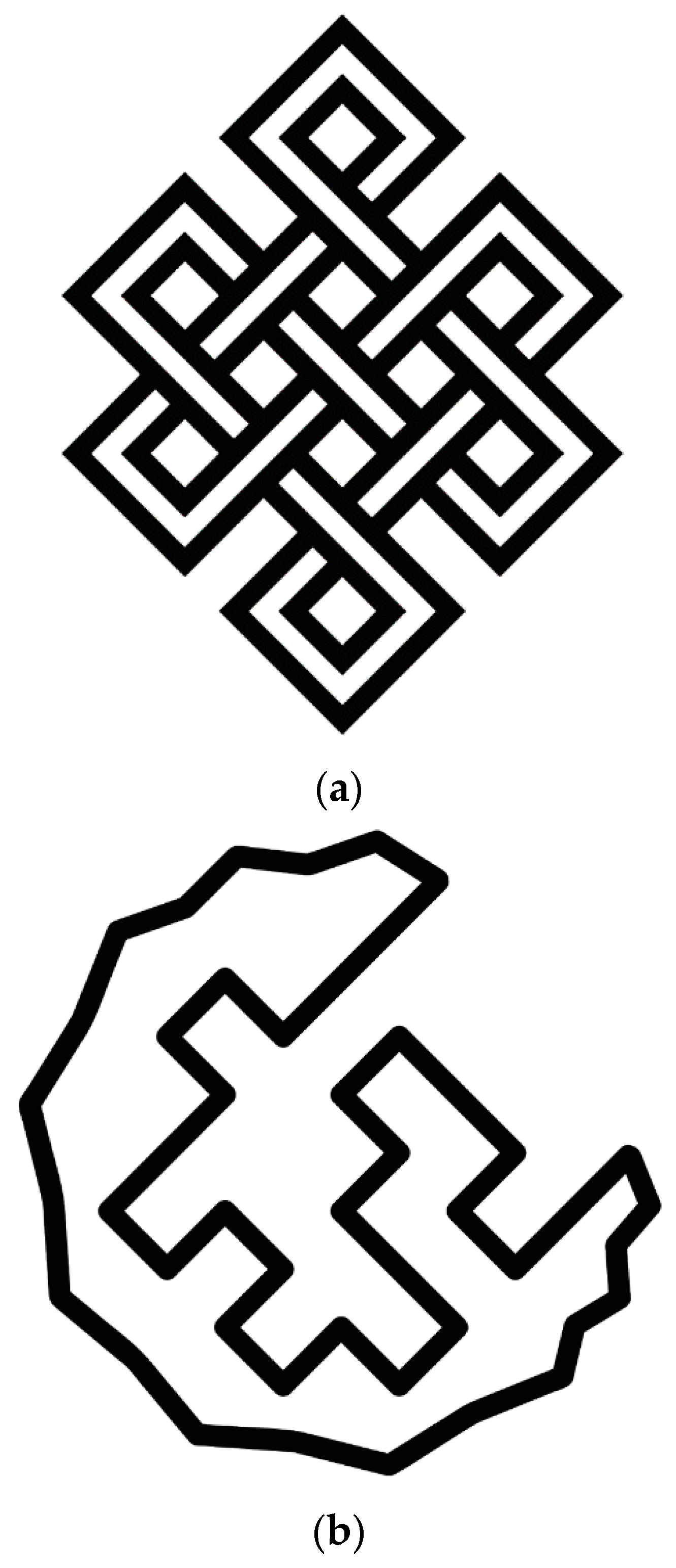

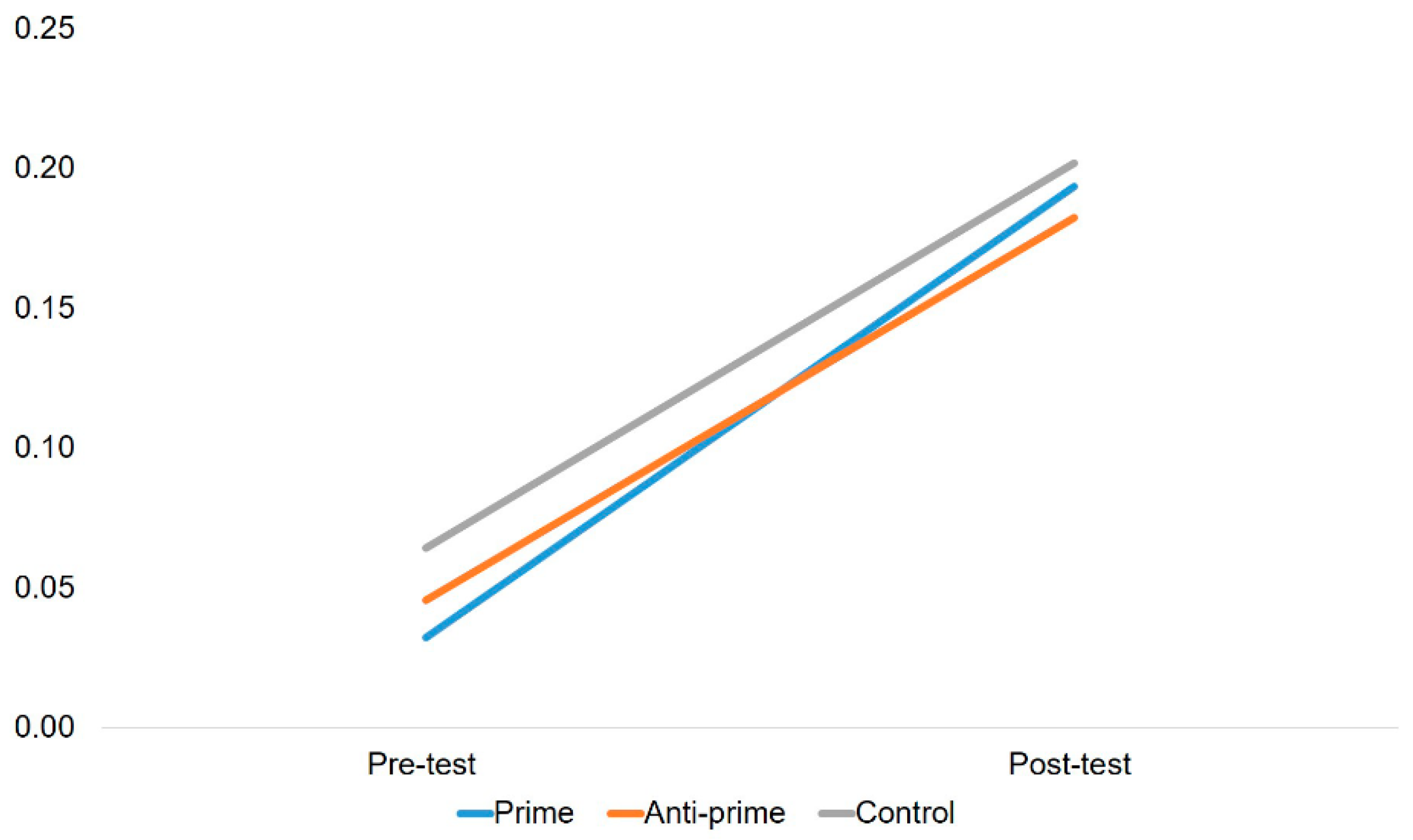
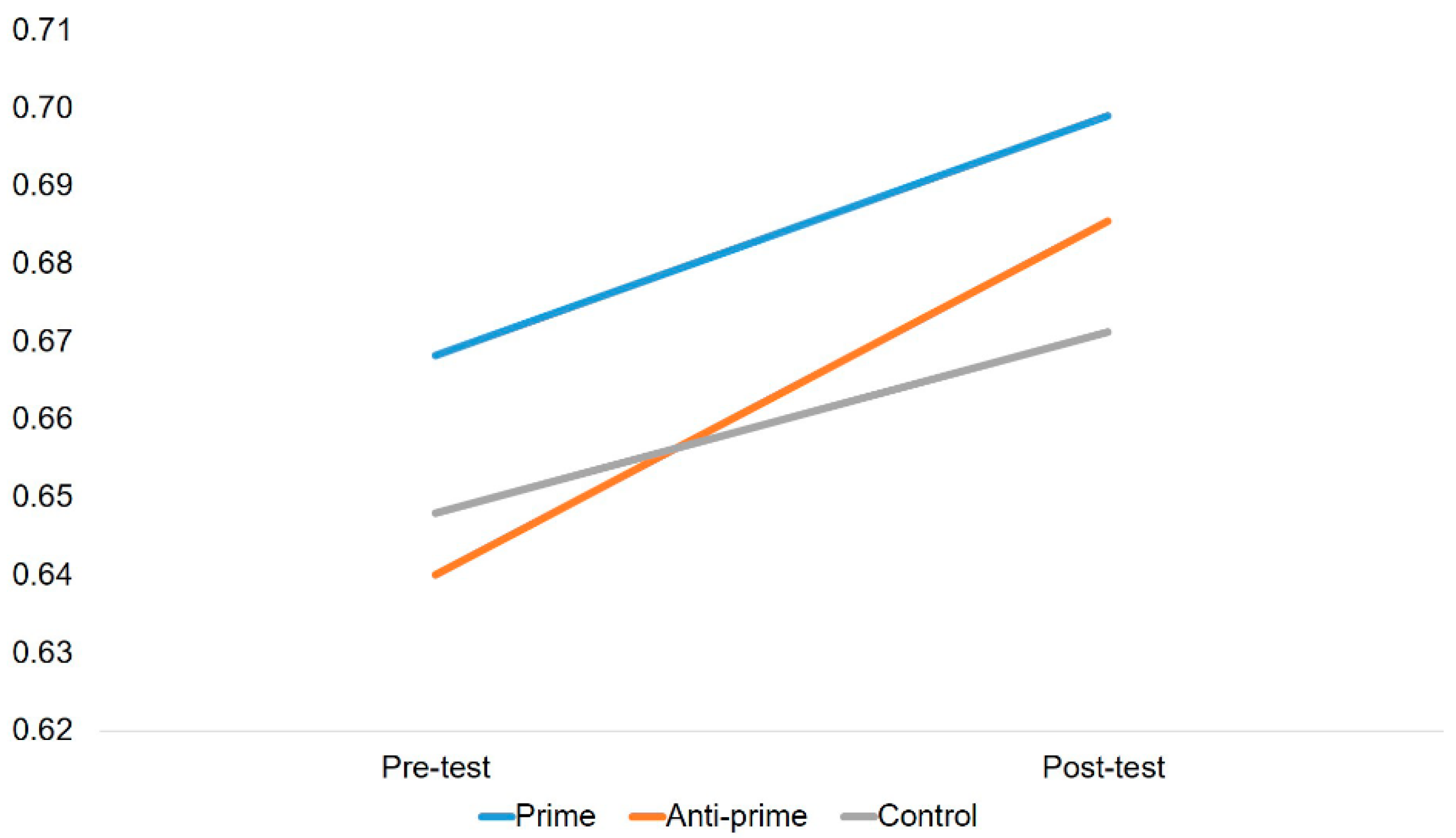

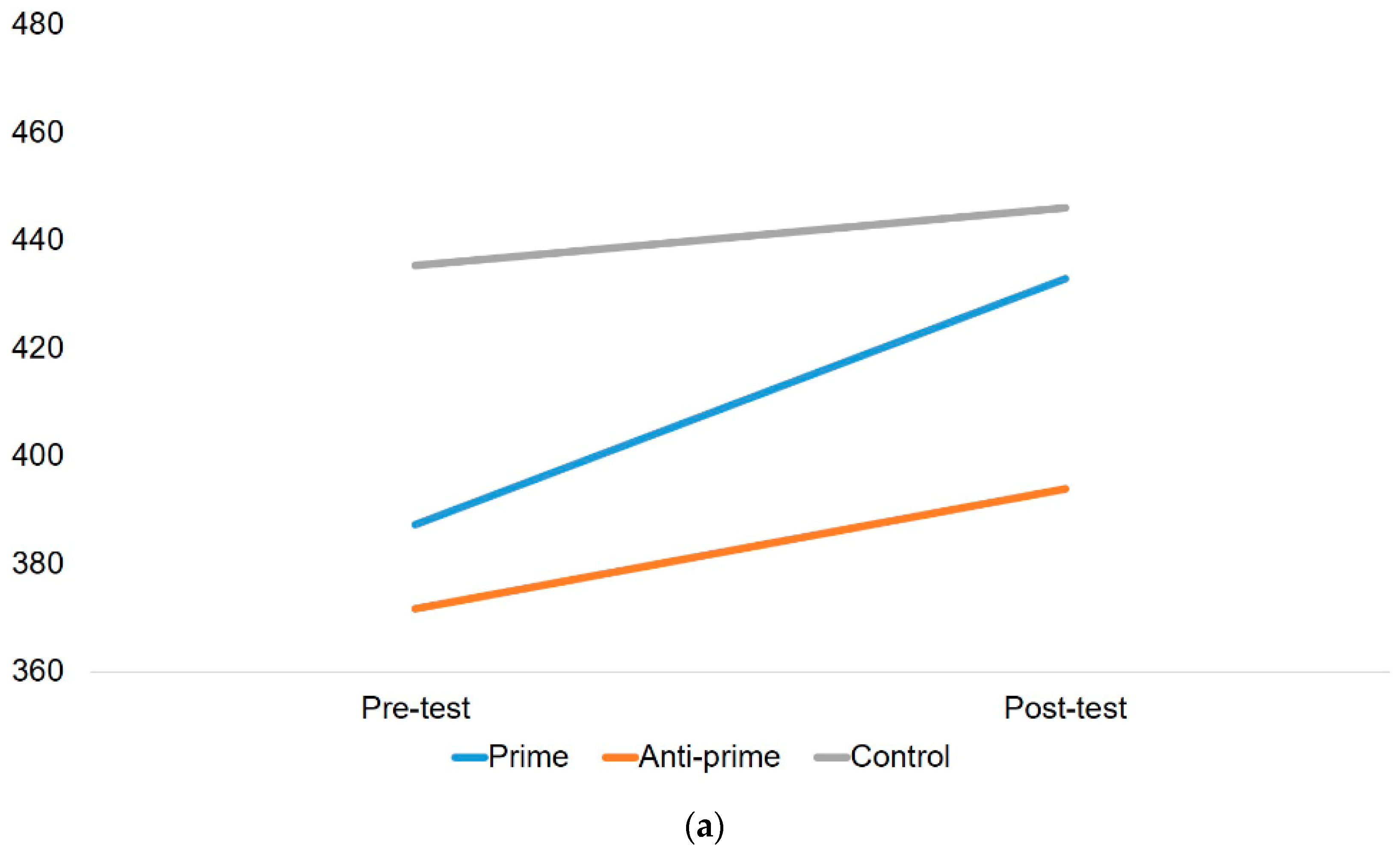
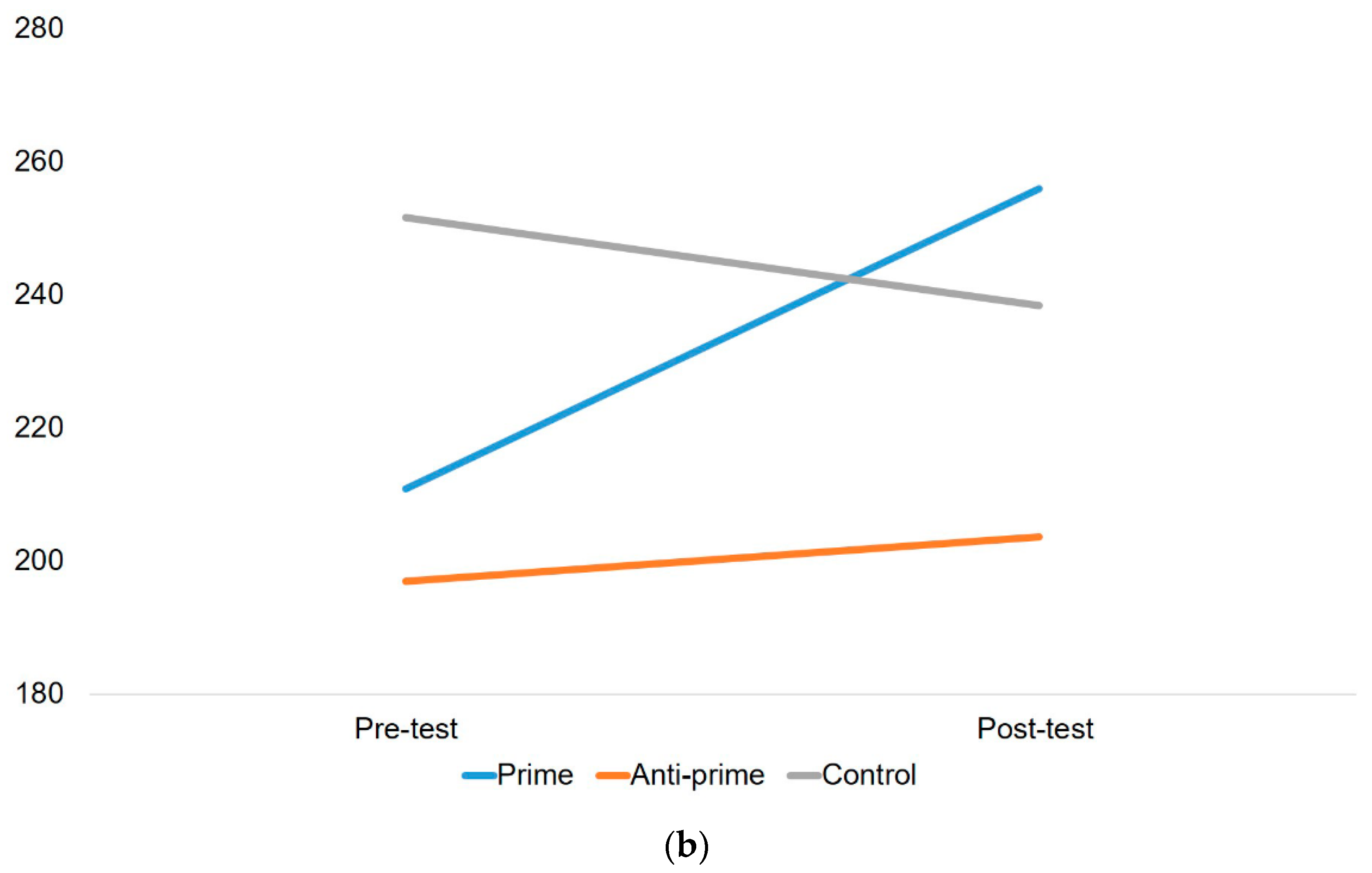

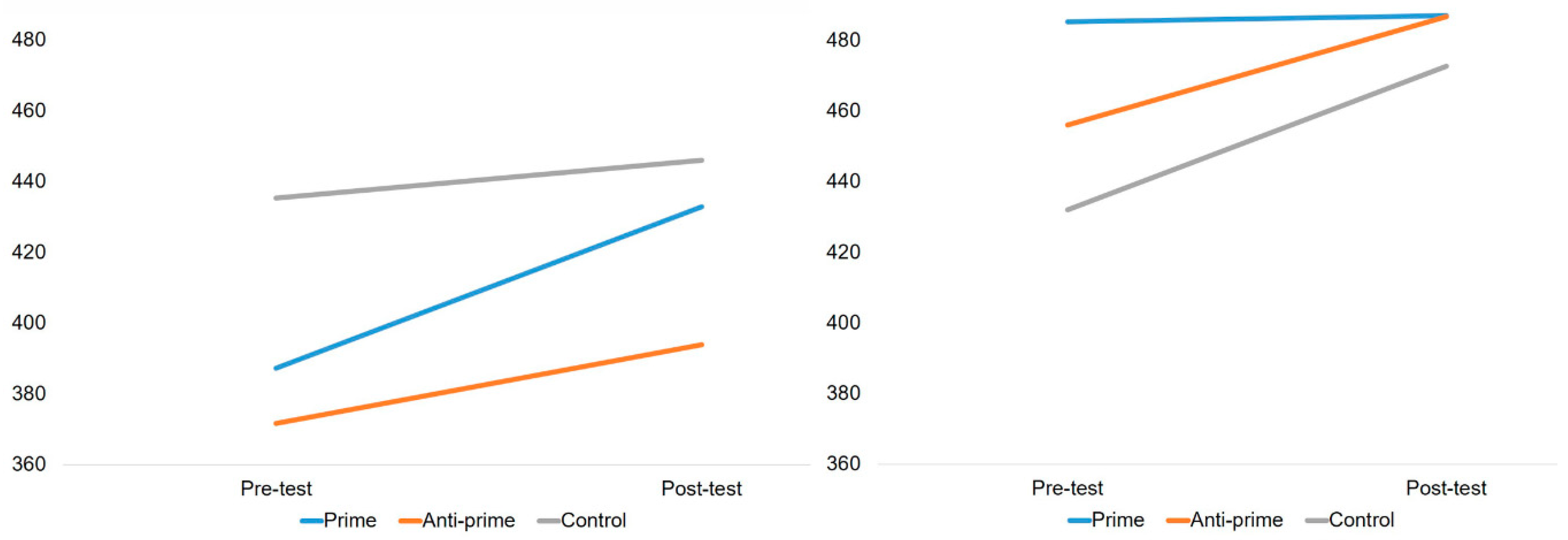
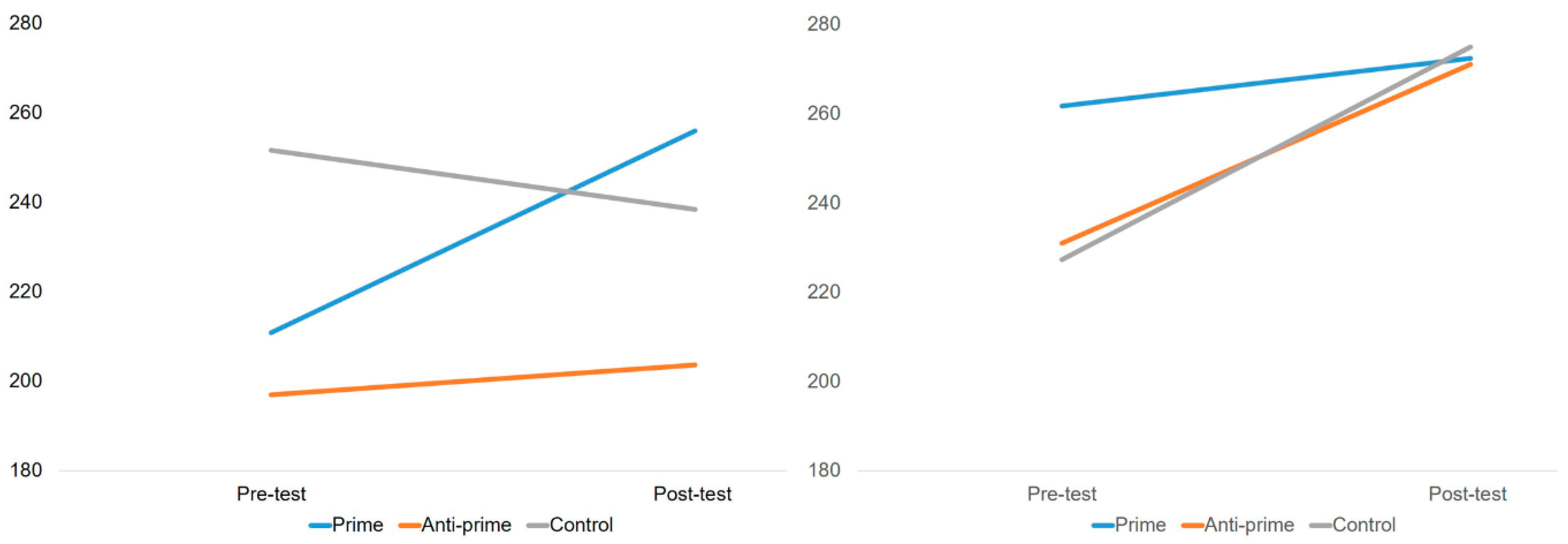
| Variable | Condition | |||||
|---|---|---|---|---|---|---|
| Prime | Anti-Prime | Control | ||||
| Pre-Test | Post-Test | Pre-Test | Post-Test | Pre-Test | Post-Test | |
| RAT | 0.03 (0.09) | 0.19 (0.14) | 0.05 (0.09) | 0.18 (0.15) | 0.06 (0.11) | 0.20 (0.17) |
| VAT | 0.67 (0.14) | 0.70 (0.17) | 0.64 (0.15) | 0.69 (0.16) | 0.65 (0.17) | 0.67 (0.22) |
| RST | 0.33 (0.20) | 0.16 (0.21) | 0.29 (0.22) | 0.19 (0.21) | 0.36 (0.21) | 0.21 (0.23) |
| AFT: TSD 1 | 415.22 (267.13) | 432.92 (272.5) | 399.37 (245.34) | 393.93 (232.44) | 459 (305.59) | 437.92 (243.55) |
| AFT: CDSD 2 | 211 (250.3) | 255.94 (261.05) | 196.93 (212.48) | 203.65 (212.20) | 246.67 (276.94) | 233.77 (229.29) |
| Age | 18.92 (1.97) | 19.24 (2.68) | 19.41 (1.68) | |||
| Gender 3 | 84.30% | 70.70% | 78.40% | |||
| FFMQ | 0.66 (0.08) | 0.64 (0.08) | 0.62 (0.08) | |||
| Variable | Condition | |||||
|---|---|---|---|---|---|---|
| Prime | Anti-Prime | Control | ||||
| Pre-Test | Post-Test | Pre-Test | Post-Test | Pre-Test | Post-Test | |
| AFT: TSD 1 | 485.2 (301.73) | 487.04 (324.65) | 456.04 (285.79) | 486.76 (326.81) | 431.96 (310.45) | 472.6 (287.52) |
| AFT: CDSD 2 | 261.72 (279.49) | 272.46 (318.30) | 231.00 (265.81) | 271.08 (317.75) | 227.26 (275.05) | 274.96 (279.32) |
| Age | 19.66 (2.40) | 19.48 (1.98) | 19.80 (2.27) | |||
| Gender 3 | 74% | 74% | 70% | |||
| FFMQ | 62.03 (7.98) | 62.75 (7.88) | 63.44 (7.42) | |||
Publisher’s Note: MDPI stays neutral with regard to jurisdictional claims in published maps and institutional affiliations. |
© 2020 by the authors. Licensee MDPI, Basel, Switzerland. This article is an open access article distributed under the terms and conditions of the Creative Commons Attribution (CC BY) license (http://creativecommons.org/licenses/by/4.0/).
Share and Cite
Vahedi, Z.; Pelkey, J.; Park, S.; Walsh Matthews, S. Testing Symmetrical Knot Tracing for Cognitive Priming Effects Rules out Analytic Analogy. Symmetry 2021, 13, 34. https://doi.org/10.3390/sym13010034
Vahedi Z, Pelkey J, Park S, Walsh Matthews S. Testing Symmetrical Knot Tracing for Cognitive Priming Effects Rules out Analytic Analogy. Symmetry. 2021; 13(1):34. https://doi.org/10.3390/sym13010034
Chicago/Turabian StyleVahedi, Zahra, Jamin Pelkey, Sari Park, and Stéphanie Walsh Matthews. 2021. "Testing Symmetrical Knot Tracing for Cognitive Priming Effects Rules out Analytic Analogy" Symmetry 13, no. 1: 34. https://doi.org/10.3390/sym13010034
APA StyleVahedi, Z., Pelkey, J., Park, S., & Walsh Matthews, S. (2021). Testing Symmetrical Knot Tracing for Cognitive Priming Effects Rules out Analytic Analogy. Symmetry, 13(1), 34. https://doi.org/10.3390/sym13010034






